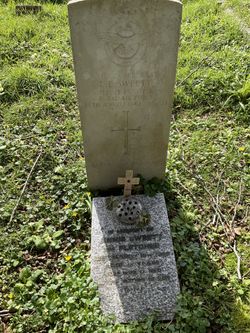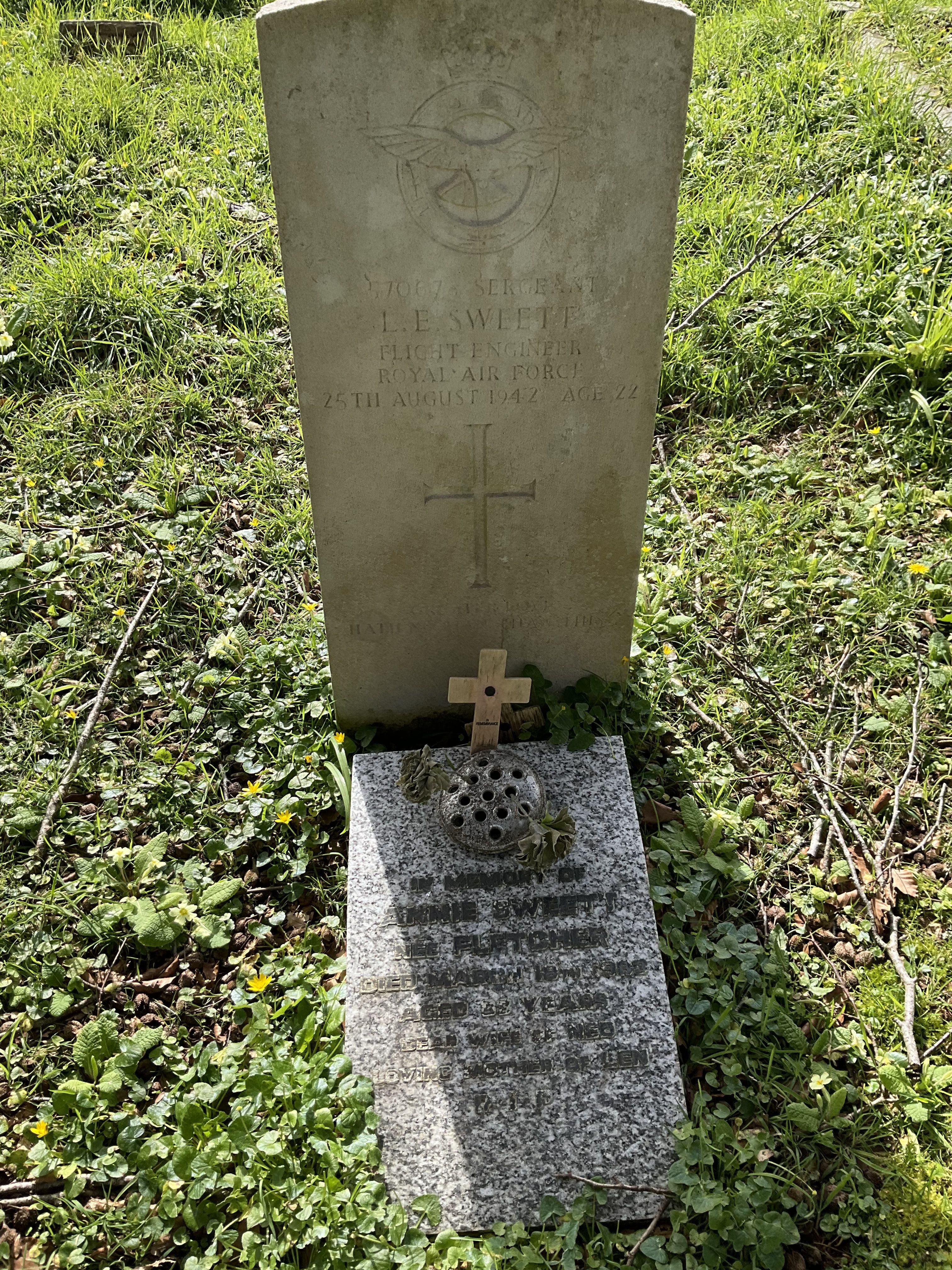228 Sqdn. Royal Air Force
Unit Text:
Age: 22
Son of Edward and Annie Sweett, of Looe; husband of Hilda Sweett.
On 25th August 1942, Prince George, Duke of Kent, took off from Invergordon in an S-25 Sunderland Mk III Flying Boat. The official story is the Duke was on a morale-boosting visit to RAF personnel stationed in Iceland. The crew had been carefully selected for the task. The captain, Flight Lieutenant Frank Goyen, was considered to be Sunderland flyer in the RAF and had flown some of Britain's politicians during the war. The rest of the crew Sgt Edward Francis Blacklock FO Sydney Wood Smith was also highly regarded. The co-pilot was
Wing Commander Thomas Lawton Mosley, the commanding officer of 228 Squadron. Mosley was one of the RAF's most experienced pilots having completed 1,449 flying hours. He was also a navigation specialist and was a former instructor at the School of Navigation.
Officially the Duke of Kent was one of fifteen people on board the aircraft. Also on board were Prince George's private secretary Lieutenant John Lowther, his equerry
PO Micheal Strutt and his valet LAC John Hales.
The flying boat took off from Invergordon on the east coast of Scotland at 1.10 p.m. Being a flying boat, its standing orders were to fly over water, only crossing land when absolutely unavoidable. The route was to follow the coastline to Duncansby Head – the northernmost tip of Scotland – and then turn northwest over the Pentland Firth towards Iceland.
The S-25 Sunderland Mk III crashed into Eagle's Rock later that afternoon (there is much dispute about the exact time this happened) at a height of around 650 feet. As you can see from the map below, the flying boat was well off course when the accident happened. Its 2,500 gallons of fuel, carried in the wings, exploded.
Crew-
Prince George, Duke of Kent.
Lieutenant John Crowther, RNVR, Private Secretary.
Pilot Officer The Hon. Michael Strutt. RCAF.
Leading Aircraftman John Walter Hales, Batman.
Flight Lieutenant Frank McKenzie Goyen, Captain.
Wing Commander Thomas Mosley, Australian CO of 228 squadron, 1st pilot..
Pilot Officer Sidney Wood Smith, 2nd pilot.Pilot Officer George Saunders, Navigator.
Flight Sergeant William Jones, Fitter / Mechanic and Air Gunner.
Flight Sergeant Charles Lewis, Airframe Fitter..
Flight Sergeant Ernest Hewardine, WEM / AG.
Sergeant Edward Blacklock, RNZAF, WOP / AG..
Segeant Arthur Roland Catt, WOP / AG..
Sergeant Leonard Sweett, Fitter.
Sergeant Andrew S.W. Jack WOP / AG. (SURVIVED Died of cirrhosis of the liver in 1987)
Just ten days after the death of the Duke of Kent, another flying boat, also from 228 Squadron, crashed in the Scottish Highlands. The official explanation was that the plane had run out of fuel. Everyone on board was killed, including a very interesting passenger, Fred Nancarrow , a journalist from Glasgow. Nancarrow was investigating the Eagle Rock crash.
228 Sqdn. Royal Air Force
Unit Text:
Age: 22
Son of Edward and Annie Sweett, of Looe; husband of Hilda Sweett.
On 25th August 1942, Prince George, Duke of Kent, took off from Invergordon in an S-25 Sunderland Mk III Flying Boat. The official story is the Duke was on a morale-boosting visit to RAF personnel stationed in Iceland. The crew had been carefully selected for the task. The captain, Flight Lieutenant Frank Goyen, was considered to be Sunderland flyer in the RAF and had flown some of Britain's politicians during the war. The rest of the crew Sgt Edward Francis Blacklock FO Sydney Wood Smith was also highly regarded. The co-pilot was
Wing Commander Thomas Lawton Mosley, the commanding officer of 228 Squadron. Mosley was one of the RAF's most experienced pilots having completed 1,449 flying hours. He was also a navigation specialist and was a former instructor at the School of Navigation.
Officially the Duke of Kent was one of fifteen people on board the aircraft. Also on board were Prince George's private secretary Lieutenant John Lowther, his equerry
PO Micheal Strutt and his valet LAC John Hales.
The flying boat took off from Invergordon on the east coast of Scotland at 1.10 p.m. Being a flying boat, its standing orders were to fly over water, only crossing land when absolutely unavoidable. The route was to follow the coastline to Duncansby Head – the northernmost tip of Scotland – and then turn northwest over the Pentland Firth towards Iceland.
The S-25 Sunderland Mk III crashed into Eagle's Rock later that afternoon (there is much dispute about the exact time this happened) at a height of around 650 feet. As you can see from the map below, the flying boat was well off course when the accident happened. Its 2,500 gallons of fuel, carried in the wings, exploded.
Crew-
Prince George, Duke of Kent.
Lieutenant John Crowther, RNVR, Private Secretary.
Pilot Officer The Hon. Michael Strutt. RCAF.
Leading Aircraftman John Walter Hales, Batman.
Flight Lieutenant Frank McKenzie Goyen, Captain.
Wing Commander Thomas Mosley, Australian CO of 228 squadron, 1st pilot..
Pilot Officer Sidney Wood Smith, 2nd pilot.Pilot Officer George Saunders, Navigator.
Flight Sergeant William Jones, Fitter / Mechanic and Air Gunner.
Flight Sergeant Charles Lewis, Airframe Fitter..
Flight Sergeant Ernest Hewardine, WEM / AG.
Sergeant Edward Blacklock, RNZAF, WOP / AG..
Segeant Arthur Roland Catt, WOP / AG..
Sergeant Leonard Sweett, Fitter.
Sergeant Andrew S.W. Jack WOP / AG. (SURVIVED Died of cirrhosis of the liver in 1987)
Just ten days after the death of the Duke of Kent, another flying boat, also from 228 Squadron, crashed in the Scottish Highlands. The official explanation was that the plane had run out of fuel. Everyone on board was killed, including a very interesting passenger, Fred Nancarrow , a journalist from Glasgow. Nancarrow was investigating the Eagle Rock crash.
Sponsored by Ancestry
Advertisement
Advertisement




